Related Research Articles
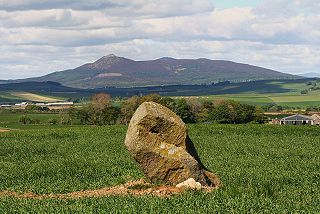
The Battle of Harlaw was a Scottish clan battle fought on 24 July 1411 just north of Inverurie in Aberdeenshire. It was one of a series of battles fought during the Middle Ages between the barons of northeast Scotland against those from the west coast.

Argyll, sometimes called Argyllshire, is a historic county and registration county of western Scotland.

Clan Chattan is a unique confederation of Highland clans. The clan is distinctive in highland clan history in that it was acknowledged to be a community or confederation, of twelve separate Scottish clans, who each had their own clan chief recognized under Scottish law, but who were united under and bound to a superior chief of the confederation for mutual solidarity, sustenance and protection in the Middle Ages and early modern period in the Scottish Highlands.

Clan Macpherson is a Highland Scottish clan and a member of the Chattan Confederation.

Tarbert is the main community on Harris in the Western Isles of Scotland. The name means "isthmus", "crossing point" or "portage", in Gaelic. The isthmus, between the sea lochs West Loch Tarbert and East Loch Tarbert, joins south Harris to north Harris and Lewis. In 1981 it had a population of 503.

Carinish, is a hamlet on North Uist, in the Outer Hebrides, Scotland. It is in the south of the island, about two miles from the causeway to Benbecula. The hamlet is known for the Carinish Stone Circle and the Trinity Temple. Carinish is within the parish of North Uist and is situated on the A865.
Ardchattan and Muckairn is a civil parish within Argyll and Bute in Scotland. It lies north of Oban, bordering Loch Etive and includes Glen Ure, Glen Creran, Barcaldine, Benderloch, Connel, Bonawe and Glen Etive. At the 2001 census, Ardchattan and Muckairn had a population of 2,443, between them. Its name derives from the 6th-century Irish monk Saint Cathan, combined with the Goidelic element ard-, or "heights".

The Battle of Mulroy was a Scottish clan battle fought in August 1688 in the Lochaber district of Scotland. It was fought between the Clan Mackintosh who were supported by government troops under Kenneth Mackenzie of Suddie against the Clan MacDonald of Keppoch who were supported by the Clan Cameron over disputed lands in the Braes of Lochaber. The battlefield has been inventoried and protected by Historic Scotland under the Scottish Historical Environment Policy of 2009.

The Battle of Clachnaharry was a Scottish clan battle that took place in the year 1454. It was fought between the Clan Munro and the Clan Mackintosh on the south bank of the Beauly Firth at Clachnaharry, on the outskirts of Inverness.

Kilchattan Bay is a village on the Isle of Bute, Scotland. It lies on the island's southern end, along the coast road at the foot of a steep hill called the Suidhe Chattan which shields the village from the prevailing westerly wind. The village faces the mainland to the east across the Firth of Clyde. A sandy bay known locally as the Wee Bay sweeps around to the north.

Colonsay is an island in the Inner Hebrides of Scotland, located north of Islay and south of Mull. The ancestral home of Clan Macfie and the Colonsay branch of Clan MacNeil, it is in the council area of Argyll and Bute and has an area of 4,074 hectares. Aligned on a south-west to north-east axis, it measures 8 miles in length and reaches 3 mi (5 km) at its widest point.
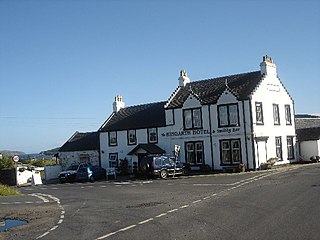
Kingarth is a historic village and parish on the Isle of Bute, off the coast of south-western Scotland. The village is within the parish of its own name, and is situated at the junction of the A844 and B881. In the Early Middle Ages it was the site of a monastery and bishopric and the cult centre of Saints Cathan and Bláán.
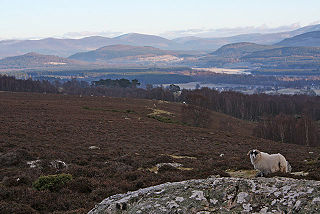
Dunachton is an estate on the north-west shore of Loch Insh in Badenoch and Strathspey, in the Highlands of Scotland. It occupies land immediately to the north of the A9 road and General Wade's Military Road.
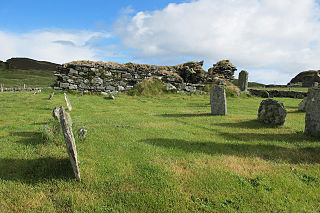
St Cathan's Chapel is a ruined chapel on the island of Colonsay, Scotland in the Inner Hebrides. It was dedicated to Cathan, an obscure saint once venerated across the western Scottish islands. It is located at grid reference NR3629095026, in the settlement of Lower Kilchattan.

Innes Chonnel Castle or Ardchonnel Castle is a ruined 13th-century castle on Innis Chonnell, an island on Loch Awe near Dalavich, Argyll and Bute, Scotland. The fortress was once a stronghold of Clan Campbell.

Old Castle Lachlan, also known as Castle Lachlan, is a ruined 15th-century castle on the shore of Loch Fyne, within the Cowal Peninsula, in Argyll and Bute, Scotland. It was probably built by Clan Maclachlan on lands first recorded in 1314 as "Castlelachlan". Nothing remains of this fourteenth-century castle. Instead, the enclosure of Old Castle Lachlan appears to date to the early fifteenth century, whilst the internal buildings seem to date to the later part of the century. The castle remained a residence of the clan's chiefs until New Castle Lachlan was built as a replacement in 1790, 0.8 kilometres (0.5 mi) east-north-east.
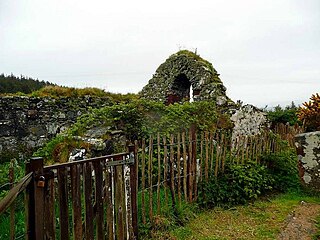
Kilchattan Chapel is a ruined medieval chapel near Ardminish, Isle of Gigha, Argyll and Bute, Scotland. Built in the 13th century, the chapel was dedicated to St. Cathan.

Kelspoke Castle is a ruined castle overlooking Kilchattan Bay, Isle of Bute, Scotland. Only a small amount of the ruins are above ground.

Tor Castle is a ruined castle, about 3 miles north east of Fort William, Highland, Scotland, west of the River Lochy and east of the Caledonian Canal, near Torlundy.

Clan MacPhail or the Sons of Paul is a Scottish clan of the Scottish Highlands. Known in Scottish Gaelic as Conchie Dhu or Condochy Doye, the clan is mainly associated with the confederation of Clan Chattan.
References
- "Colonsay, Kilchattan, Old Parish Church And Well". CANMORE . Royal Commission on the Ancient and Historical Monuments of Scotland . Retrieved 23 November 2015.
- "Kilchattan Chapel". CANMORE . Royal Commission on the Ancient and Historical Monuments of Scotland . Retrieved 23 November 2015.
- "Luing, Kilchattan Church". CANMORE . Royal Commission on the Ancient and Historical Monuments of Scotland . Retrieved 23 November 2015.
- "The Statistical Account of Buteshire", 1822, from Creag Dubh, No. 18 (1966)
- Butler, Alban (1815). The Lives of the Fathers, Martyrs, and Other Principal Saints. J. Murphy. Retrieved 12 January 2010.
- Innes, Cosmo; et al. (1854). Origines parochiales Scotiae. Vol. 2. W.H. Lizars. Retrieved 12 January 2010.
- Mackinlay, James Murray (1904). Influence of the Pre-Reformation Church on Scottish Place-names. W. Blackwood. Retrieved 12 January 2010.